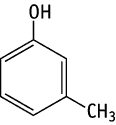

The single dose toxicity test of 3-methylphenol revealed LD50 values of 2241 mg/kg for males and 2007 mg/kg for females.
In a repeat dose toxicity test of 3-methylphenol, no adverse effects were observed in the 100 mg/kg group. In the 300 mg/kg group, females showed an increase in relative liver weights. In the 1000 mg/kg group, males and females showed tremors and or salivation throughout the administration period. Body weights and food consumption were low in these animals. Urinalysis showed low pH and negative protein in males and females, and increases in urinary volume and water consumption in males. An increase in serum total cholesterol was observed in males and females. Relative liver weights in males and females and relative kidney weights in females were increased. Histopathological examination revealed hypertrophy of centrilobular hepatocytes in one male. These changes were not observed at the end of the recovery period.
The NOELs for repeat dose toxicity are considered to be 300 mg/kg/day for males and 100 mg/kg/day for females.
Genotoxicity of 3-methylphenol was studied by reverse mutation test in bacteria and by chromosomal aberration test in cultured Chinese hamster lung (CHL/IU) cells.
3-Methylphenol was not mutagenic in Salmonella typhimurium TA100, TA1535, TA98, TA1537 and Escherichia coli WP2 uvrA, with or without an exogenous metabolic activation system.
3-Methylphenol induced structural chromosomal aberrations in CHL/IU cells after short-term treatment, with and without an exogenous metabolic activation system.
| Purity | : | 99.13 % |
| Test species/strains | : | Rat/Crj:CD(SD)IGS |
| Test method | : | OECD Test Guideline 401 |
| Route | : | Oral (gavage) |
| Doses | : | 0(vehicle), 1430, 1640, 1890, 2170, 2500 mg/kg |
| Number of animals/group | : | Males, 5; females, 5 |
| Vehicle | : | Olive oil |
| GLP | : | Yes |
Test results:
| Purity | : | 99.13 % |
| Test species/strain | : | Rat/Crj:CD(SD)IGS |
| Test method | : | Guideline for 28-Day Repeated Dose Toxicity Test in Mammalian Species (Chemical Substances Control Law of Japan) |
| Route | : | Oral(gavage) |
| Doses | : | 0(vehicle), 100, 300, 1000 mg/kg/day |
| Number of animals/group | : | Males and females, 14, 7, 7 and 14/group for the 0, 100, 300 and 1000 mg/kg cases, respectively |
| Vehicle | : | Olive oil |
| Administration period | : | Males and females, 28 days |
| Terminal kill | : | Days 29 and 43 |
| GLP | : | Yes |
Test results:
| Purity | : | 99.13 % |
| Test species/strains | : | Salmonella typhimurium TA100, TA1535, TA98, TA1537, Escherichia coli WP2 uvrA |
| Test method | : | Guidelines for Screening Mutagenicity Testing of Chemicals(Chemical Substances Control Law of Japan) and OECD Test Guideline 471 |
| Procedures | : | Pre-incubation method |
| Solvent | : | DMSO |
| Positive controls | : | -S9 mix; 2-(2-Furyl)-3-(5-nitro-2-furyl)acrylamide (TA100, TA98, WP2 uvrA), Sodium azide (TA1535) and
9-Aminoacridine (TA1537) +S9 mix; 2-Aminoanthracene (all strains) |
| Doses | : | -S9 mix; 0, 156, 313, 625, 1250, 2500, 5000 μg/plate +S9 mix; 0, 156, 313, 625, 1250, 2500, 5000 μg/plate |
| S9 | : | Rat liver, induced with phenobarbital and 5,6-benzoflavone |
| Plates/test | : | 3 |
| Number of replicates | : | 2 |
| GLP | : | Yes |
Test results:
Genetic effects:
Salmonella typhimurium TA100, TA1535, TA98 and TA1537
| + | ? | - | |
| Without metabolic activation: | [ ] | [ ] | [*] |
| With metabolic activation: | [ ] | [ ] | [*] |
Escherichia coli WP2 uvrA
| + | ? | - | |
| Without metabolic activation: | [ ] | [ ] | [*] |
| With metabolic activation: | [ ] | [ ] | [*] |
| Purity | : | 99.13 % |
| Type of cell used | : | Chinese hamster lung (CHL/IU) cells |
| Test method | : | Guidelines for Screening Mutagenicity Testing of Chemical (Chemical Substances Control Law of Japan) and OECD Test Guideline 473 |
| Solvent | : | DMSO |
| Positive controls | : | -S9 mix; 1-Methyl-3-nitro-1-nitrosoguanidine +S9 mix; 3,4-Benzo[a]pyrene |
| Doses | : | -S9 mix(6 hr short-term treatment); 0, 300, 500, 700, 900, 1100 μg/mL +S9 mix(6 hr short-term treatment); 0, 12.5, 25, 50, 100, 200, 400 μg/mL |
| S9 | : | Rat liver, induced with phenobarbital and 5,6-benzoflavone |
| Plates/test | : | 2 |
| GLP | : | Yes |
Test results:
| Lowest concentration producing cytogenetic effects in vitro: | ||
| With metabolic activation (6 hr short-term treatment) | : | 25 μg/mL(clastogenicity) |
Genotoxic effects:
| clastogenicity | polyploidy | |||||
| + | ? | - | + | ? | - | |
| Without metabolic activation: | [*] | [ ] | [ ] | [ ] | [ ] | [*] |
| With metabolic activation: | [*] | [ ] | [ ] | [ ] | [ ] | [*] |
| 1) | The tests were performed by the Safety Research Institute for Chemical Compounds Co., Ltd., 363-24, Shin-ei, Kiyota-ku, Sapporo, Hokkaido, 004-0839, Japan. Tel +81-11-885-5031 Fax +81-11-885-5313 |
| 2) | The tests were performed by the Research Institute for Animal Science in Biochemistry and Toxicology, 3-7-11 Hashimotodai, Sagamihara-shi, Kanagawa 229-1132, Japan. Tel +81-42-762-2775 Fax +81-42-762-7979 |